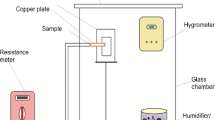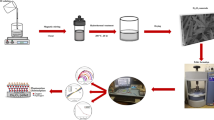Abstract
In this research, growth of full composition graded II–VI materials in different morphologies using a simple but versatile chemical vapor deposition method was demonstrated and various characterizations of those materials were carried out using X-ray diffraction, scanning electron microscopy, energy dispersive spectroscopy and photoluminescence techniques. All these techniques reveal that our materials were grown in very high crystal quality and providing a unique platform to be used for many applications. In the scope of this paper, we utilized them as humidity sensing materials as they provide a wide variety of morphology change. Humidity sensing properties of those materials were investigated under various humidity levels using quartz crystal microbalance (QCM) system. It was revealed that ZnS-rich ZnCdSSe nanowires have more adsorption sites compared to the other morphologies, namely tapered nanobelt, nanosheet and thin film, and this makes them more sensitive than others. Overall, the fabricated QCM sensors exhibited fast response, high sensitivity and narrow hysteresis and therefore they are very promising for everyday appliances and various manufacturing environments with their easy operation, high sensitivity and stability, ability to work at room temperature and low cost.





Similar content being viewed by others
References
E. Joanni, R. Savu, L. Valadares, M. Cilense, M.A. Zaghete, Thermal evaporation furnace with improved configuration for growing nanostructured inorganic materials. Rev. Sci. Instrum. 82, 065101 (2011)
Y. Chen, C. Zhu, T. Wang, The enhanced ethanol sensing properties of multi-walled carbon nanotubes/SnO2 core/shell nanostructures. Nanotechnology 17, 3012–3017 (2006)
F.H. Ramirez, J.D. Prades, A. Hackner, T. Fisher, G. Mueller, S. Mathur, J.R. Morante, Miniaturized ionization gas sensors from single metal oxide nanowires. Nanoscale 3, 630–634 (2011)
G.C. Yi, Semiconductor Nanostructures for Optoelectronic Devices: Processing, Characterization and Applications (Springer, Berlin, 2012)
S. Logothetidis, Nanostructured Materials and Their Applications (Springer, Berlin, 2012)
G. Cao, Y. Wang, Chapter 2, in Nanostructures and Nanomaterials: Synthesis, Properties and Applications (Imperial College Press, London, 2004)
T. Kuykendall, P. Ulrich, S. Aloni, P. Yang, Complete composition tunability of InGaN nanowires using a combinatorial approach. Nat. Mater. 6, 12 (2007)
Y. Wang, J. Xu, P. Ren, Q. Zhang, X. Zhuang, X. Zhu, Q. Wan, H. Zhou, W. Hu, A. Pan, Bandgap broadly tunable GaZnSeAs alloy nanowires. Phys. Chem. Chem. Phys. 15, 8 (2013)
S. Turkdogan, F. Fan, C.Z. Ning, Color-temperature tuning and control of trichromatic white light emission from a multisegment ZnCdSSe heterostructure nanosheet. Adv. Funct. Mater. 26, 8521–8526 (2016)
S.H. Song, H.H. Yang, C.H. Han, S.D. Ko, S.H. Lee, J.B. Yoon, Metal–oxide–semiconductor field effect transistor humidity sensor using surface conductance. Appl. Phys. Lett. 100, 101603 (2012)
B. Patissier, Humidity sensors for automotive, appliances and consumer applications. Sens. Actuators B 59, 231–234 (1999)
D. Bridgeman, J. Corral, A. Quach, X. Xian, E. Forzani, Colorimetric humidity sensor based on liquid composite materials for the monitoring of food and pharmaceuticals. Langmuir 30, 10785–10791 (2014)
D. Cartasegna, F. Conso, A. Donida, M. Grassi, L. Picolli, G. Rescio et al., Integrated microsystem with humidity, temperature and light sensors for monitoring the preservation conditions of food. Sensors 25, 1859–1862 (2011)
L. Gu, Q.A. Huang, M. Qing, A novel capacitive-type humidity sensor using CMOS fabrication technology. Sens. Actuators B 99, 491–498 (2004)
L. Alwis, T. Sun, K.V. Grattan, Analysis of polyimide-coated optical fiber long period grating-based relative humidity sensor. IEEE Sens. J. 13, 767–771 (2013)
J.K. Kwan, J.C. Sit, High sensitivity Love-wave humidity sensors using glancing angle deposited thin films. Sens. Actuators B 173, 164–168 (2012)
H.T. Hsueh, S.J. Chang, F.Y. Hung, C.L. Hsu, B.T. Dai, K.T. Lam, K.H. Wen, A flexible ZnO nanowire-based humidity sensor. IEEE Trans. Nanotechnol. 11, 520–525 (2012)
B.M. Kulwicki, Humidity sensors. J. Am. Ceram. Soc. 74, 697–708 (1991)
V.P. Anju, P.R. Jithesh, S.K. Narayanankutty, A novel humidity and ammonia sensor based on nanofibers/polyaniline/polyvinyl alcohol. Sens. Actuators A 285, 35–44 (2019)
Y.N. Guo, Z.Y. Gao, X.X. Wang, L. Sun, X. Yan, S.Y. Yan, W.P. Han, A highly stretchable humidity sensor based on spandex covered yarns and nanostructured polyaniline. RSC Adv. 8, 1078–1082 (2018)
K.N. Chappanda, O. Shekhah, O. Yassine, S.P. Patole, M. Eddaoudi, K.N. Salama, The quest for highly sensitive QCM humidity sensors: the coating of CNT/MOF composite sensing films as case study. Sens. Actuators B 257, 609–619 (2018)
X. Cha, F. Yu, Y. Fan, J. Chen, L. Wang, Q. Xiang, J. Xu, Superhydrophilic ZnO nanoneedle array: controllable in situ growth on QCM transducer and enhanced humidity sensing properties and mechanism. Sens. Actuators B 263, 436–444 (2018)
T.A. Blank, L.P. Eksperiandova, K.N. Belikov, Recent trends of ceramic humidity sensors development: a review. Sens. Actuators B 228, 416–442 (2016)
X. Chen, X. Chen, N. Li, X. Ding, X. Zhao, A QCM humidity sensors based on GO/Nafion composite films with enhanced sensitivity. IEEE Sens. J. 16, 8874–8883 (2016)
Y. Yao, X. Chen, W. Ma, W. Ling, Quartz crystal microbalance humidity sensors based on nanodiamond sensing films. IEEE Trans. Nanotechnol. 13, 386–393 (2014)
N. Asar, A. Erol, S. Okur, M.C. Arikan, Morphology-dependent humidity adsorption kinetics of ZnO nanostructures. Sens. Actuators A 187, 37–42 (2012)
S. Okur, N. Üzar, N. Tekgüzel, A. Erol, M.Ç. Arıkan, Synthesis and humidity sensing analysis of ZnS nanowires. Physica E 44, 1103–1107 (2012)
A. Erol, S. Okur, N. Yağmurcukardeş, M.Ç. Arıkan, Humidity-sensing properties of a ZnO nanowire film as measured with a QCM. Sens. Actuators B 152, 115–120 (2011)
A. Erol, S. Okur, B. Comba, Ö. Mermer, M.C. Arıkan, Humidity sensing properties of ZnO nanoparticles synthesized by sol–gel process. Sens. Actuators B 145, 174–180 (2010)
F. Pascal-Delannoy, B. Sorli, A. Boyer, Quartz crystal microbalance (QCM) used as humidity sensor. Sens. Actuators A 84, 285–291 (2000)
K. Galatsis, W. Qu, W. Wlodarski, Quartz crystal microbalance humidity sensor with porous electrodes, in 1998 Conference on Optoelectronic and Microelectronic Materials Devices, 1998. Proceedings (IEEE, 1999), pp. 373–375
Ş.D. Zor, H. Cankurtaran, QCM humidity sensors based on organic/inorganic nanocomposites of water soluble-conductive poly (diphenylamine sulfonic acid). Int. J. Electrochem. Sci. 11, 7976–7989 (2016)
R.S. Wagner, W.C. Ellis, Vapor–solid–liquid mechanism of single crystal growth. Appl. Phys. Lett. 4, 89 (1964)
F. Fan, S. Turkdogan, Z. Liu, D. Shelhammer, C.Z. Ning, A monolithic white laser. Nat. Nanotechnol. 10, 796 (2015)
G.H. Gilmer, G.H. Marcia, Models of thin film growth modes. JOM 39, 6 (1987)
Y. Liu, J.A. Zapien, Y.Y. Shan, C.Y. Geng, C.S. Lee, S.T. Lee, Wavelength controlled lasing in ZnxCd1−xS single crystal nanoribbons. Adv. Mater. 17, 1372–1377 (2005)
Y. Liu, J.A. Zapien, Y.Y. Shan, H. Tang, C.S. Lee, S.T. Lee, Wavelength-tunable lasing in single-crystal CdS1−xSex nanoribbons. Nanotechnology (2007). https://doi.org/10.1088/0957-4484/18/36/365606
J.A. Zapien, Y. Liu, Y.Y. Shan, H. Tang, C.S. Lee, S.T. Lee, Continuous near-infrared-to-ultraviolet lasing from II–VI nanoribbons. Appl. Phys. Lett. 90, 213114 (2007)
S. Turkdogan, Growth and Characterization of Multisegment Chalcogenide Alloy Nanostructures for Photonic Applications in a Wide Spectral Range, Dissertation, Arizona State University, 2015
Thin Film Evaporation Guide (Lebow Corporation and Vacuum Engineering and Materials, Inc., Santa Clara, 2008)
G. Sauerbrey, The use of quartz crystal oscillators for weighing thin layers and for microweighing applications. Z. Phys. 155(3), 206–222 (1959)
T. Takahashi, P. Nichols, K. Takei, A.C. Ford, A. Jamshidi, M.C. Wu, C.Z. Ning, A. Javey, contact printing of compositionally graded CdSxSe1−x nanowire parallel arrays for tunable photodetectors. Nanotechnology (2012). https://doi.org/10.1088/0957-4484/23/4/045201
A.L. Patterson, The Scherrer formula for X-ray particle size determination. Phys. Rev. 56, 10 (1939)
A. Monshi, M.R. Foroughi, M.R. Monshi, Modified Scherrer equation to estimate more accurately nano-crystallite size using XRD. WJNSE 2, 154 (2012)
M. Su, J. Wang, Y. Hao, Development of Y3+ and Mg2+-doped zirconia thick film humidity sensors. Mater. Chem. Phys. 126, 31–35 (2011)
L. Gu, K. Zheng, Y. Zhou, J. Li, X. Mo, G.R. Patzke, G. Chen, Humidity sensors based on ZnO/TiO2 core/shell nanorod arrays with enhanced sensitivity. Sens. Actuators B 159, 1–7 (2011)
X. Zhou, J. Zhang, T. Jiang, X. Wang, Z. Zhu, Humidity detection by nanostructured ZnO: a wireless quartz crystal microbalance investigation. Sens. Actuators A 135, 209–214 (2007)
Acknowledgements
This work was supported by the Scientific Research Fund of Yalova University under the Project Number 2017/AP/140.
Author information
Authors and Affiliations
Corresponding author
Ethics declarations
Conflict of interests
The authors declare that they have no competing interests.
Additional information
Publisher's Note
Springer Nature remains neutral with regard to jurisdictional claims in published maps and institutional affiliations.
Electronic supplementary material
Below is the link to the electronic supplementary material.
Rights and permissions
About this article
Cite this article
Turkdogan, S. Bandgap engineered II–VI quaternary alloys and their humidity sensing performance analyzed by QCM. J Mater Sci: Mater Electron 30, 10427–10434 (2019). https://doi.org/10.1007/s10854-019-01384-z
Received:
Accepted:
Published:
Issue Date:
DOI: https://doi.org/10.1007/s10854-019-01384-z




